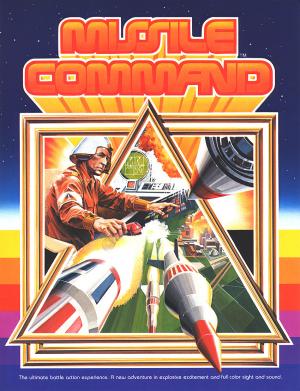

Platform: Arcade
Region: NTSC-U
Country: United States of America
Developer(s): Atari
Publishers(s): Atari, Inc.
ReleaseDate: 1980-06-15
Players: 2
Co-op: No
Missile Command
Missile Command is a 1980 arcade video game developed and released by Atari in the USA on June 15, 1980. The game is played by moving a crosshair across the sky background via a trackball and pressing one of three buttons to launch a counter-missile from the appropriate battery. Counter-missiles explode upon reaching the crosshair, leaving a fireball that persists for several seconds and destroys any enemy missiles that enter it. There are three batteries, each with ten missiles; a battery becomes useless when all its missiles have been launched or if it is destroyed by enemy fire, whichever occurs first. The missiles of the central battery fly to their targets at much greater speed; only these missiles can effectively kill a smart bomb at a distance. The game is staged as a series of levels of increasing difficulty; each level contains a set number of incoming enemy weapons. The weapons attack both the cities and the missile batteries and can destroy any target with one hit. Enemy weapons are only able to destroy three cities during one level. A level ends when all enemy weaponry is destroyed or reaches its target. A player who runs out of missiles no longer has control over the remainder of the level. At the conclusion of a level, the player receives bonus points for all remaining missiles and cities; at preset score intervals, the player earns a bonus city that can be used to replace a destroyed one at the end of the current level. These bonus cities can be kept in reserve and are automatically deployed as needed. The scoring multiplier begins at 1x and advances by 1x after every second level, to a maximum of 6x; this multiplier affects both target and bonus values. The game inevitably ends once all six cities are destroyed and the player neither has any in reserve nor earns one during the current level. Like most early arcade games, there is no way to "win"; the enemy weapons become faster and more prolific with each new level. The game, then, is just a contest in seeing how long the player can survive. On conclusion of the game, the screen displays "The End", rather than "Game Over", signifying that "In the end, all is lost. There is no winner". This conclusion is skipped, however, if the player makes the high score list and the game prompts the player to enter their initials.
Trailer: YouTube
ESRB Rating: E - Everyone
Genre(s): Action | Shooter





